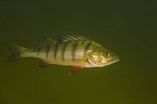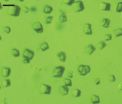(Press-News.org) Pharmaceutical drugs that end up in the world's waterways after being excreted, flushed and treated at wastewater treatment plants may lead to unexpected ecological impacts, according to a new study of wild European perch. Tomas Brodin and colleagues from Umeå University in Sweden discovered that the fish ate faster, became bolder and acted less social after being subjected to an anxiety-moderating drug, known as Oxazepam.
The psychiatric drug is used to treat anxiety in humans. But, Oxazepam residues often wind up in natural aquatic systems, downstream from sewage treatment plants, where their effects on ecosystems have been unknown. Now, Brodin and the other researchers have dosed wild perch with amounts of Oxazepam equivalent to those found in Sweden's rivers and streams, and their results suggest that even small amounts of the drug can alter the behavior and the foraging rates of these fish.
The related report appears in the 15 February issue of the journal Science, which is published by AAAS, the nonprofit science society.
"While alone, fish that were exposed to Oxazepam dared to leave safe refuge and enter novel, potentially dangerous areas," explained Brodin. "In contrast, unexposed fish stayed hidden in their refuge. The exposed fish seemed much less stressed and scared, behaving calmer and bolder."
Perch that were exposed to the drug also devoured their food quicker than unexposed fish—a behavioral quirk that the researchers say could alter the composition of species in the water and lead to ecological events, such as increased algal blooming, over time. Since fish are generally integral pieces of their food webs, changes in their eating patterns could disturb ecological balances, according to the researchers.
The fish that were given Oxazepam during the study also became anti-social, distancing themselves from other perch and putting themselves at greater risk of predation. "Perch that were exposed to Oxazepam lost interest in hanging out with the group, and some even stayed as far away from the group as possible," explained Brodin.
The fish in the study accumulated concentrations of the drug in their muscle tissues that were comparable to those found in wild fish, according to the researchers. So it's likely that the fish in Sweden's surface waters, many of which are being exposed to similarly diluted doses of Oxazepam, may be experiencing changes in their behavior and feeding rates as well, they say.
This study by Brodin and his colleagues singled out a particular psychiatric drug that has been found in natural systems. But, a veritable cocktail of drugs can be found in waterways worldwide, making the discovery of Oxazepam's effects on fish that much more important.
More comprehensive studies are needed before general conclusions can be drawn about how such pharmaceutically induced changes to behavior might affect ecosystems, but these current findings suggest that the concentrations of Oxazepam in Sweden's surface waters could have unexpected ecological and evolutionary consequences over time.
"The solution to this problem isn't to stop medicating people who are ill but to try to develop sewage treatment plants that can capture environmentally hazardous drugs," concluded Jerker Fick, a co-author of the Science report, in a press release from Umeå University.
INFORMATION:
The report by Brodin et al. was supported by a Young Researcher Award from Umeå University, the Swedish Research Council Vetenskapsrådet and FORMAS, and a small starting grant from the strong research environment "The environment's chemistry—from molecules to the ecosystem."
The American Association for the Advancement of Science (AAAS) is the world's largest general scientific society, and publisher of the journal, Science as well as Science Translational Medicine and Science Signaling. AAAS was founded in 1848, and includes some 261 affiliated societies and academies of science, serving 10 million individuals. Science has the largest paid circulation of any peer-reviewed general science journal in the world, with an estimated total readership of 1 million. The non-profit AAAS is open to all and fulfills its mission to "advance science and serve society" through initiatives in science policy; international programs; science education; and more. For the latest research news, log onto EurekAlert!, www.eurekalert.org, the premier science-news Web site, a service of AAAS.
Mood-modifying drugs for humans also alter fish behavior
Trace amounts of pharmaceuticals in rivers and streams inspire changes in wildlife
2013-02-15
ELSE PRESS RELEASES FROM THIS DATE:
Proof: Cosmic rays come from exploding stars
2013-02-15
Menlo Park, Calif. — A new study confirms what scientists have long suspected: Cosmic rays – energetic particles that pelt Earth from all directions – are born in the violent aftermath of supernovas, exploding stars throughout the galaxy.
A research team led by scientists at the Kavli Institute for Particle Astrophysics and Cosmology at the Department of Energy's (DOE) SLAC National Accelerator Laboratory sifted through four years of data from NASA's Fermi Gamma-ray Space Telescope to find the first unambiguous evidence of how cosmic rays are born.
Reporting in the ...
Rapid changes in the Arctic ecosystem during ice minimum in summer 2012
2013-02-15
This press release is available in German.
Bremerhaven, 14 February 2013. Huge quantities of algae are growing on the underside of sea ice in the Central Arctic: in 2012 the ice algae Melosira arctica was responsible for almost half the primary production in this area. When the ice melts, as was the case during the ice minimum in 2012, these algae sink rapidly to the bottom of the sea at a depth of several thousands of metres. Deep sea animals such as sea cucumbers and brittle stars feed on the algae, and bacteria metabolise what's left, consuming the oxygen in the ...
Study of insomnia finds a new predictor for suicidal thoughts
2013-02-15
DARIEN, IL – A new study confirms a link between insomnia and thoughts of suicide and suggests that this relationship is mediated by dysfunctional beliefs and attitudes about sleep as well as nightmares. The study suggests that the targeted assessment and treatment of specific sleep problems may reduce the risk of suicide in people with depressive symptoms.
"Insomnia and nightmares, which are often confused and go hand-in-hand, are known risk factors for suicide but just how they contribute was unknown," said Dr. W. Vaughn McCall, the study's lead author and chair of ...
Trolls win: Rude blog comments dim the allure of science online
2013-02-15
BOSTON – The trolls are winning.
Pick a story about some aspect of science, any story, scroll down to the blog comments and let the bashing begin:
"Wonder how much taxpayer cash went into this 'deep' study?"
"I think you can take all these studies by pointy headed scientists, 99 percent of whom are socialists and communists, and stick them where the sun don't shine."
"Yawn. Climate change myth wackos at it again."
"This article is 100 percent propaganda crapola."
"Speaking of dolts, if you were around in the 70s, when they also had scientists, the big talk ...
The role of radical prostatectomy in patients with prostate cancer
2013-02-15
Even in the presence of screening, there is benefit to radical prostatectomy (RP) in prostate cancer patients, however, the benefit is limited to a subgroup of patients and can take years to become evident according to a study published February 14 in the Journal of the National Cancer Institute.
The Scandinavian Prostate Cancer Group Study Number 4 (SPCG-4) trial identified that RP lowered prostate cancer deaths with a statistically significant absolute mortality difference (AMD) between RP and watchful waiting (WW) of 6.1%. The Prostate Cancer Intervention Versus Observation ...
The human pathogen Streptococcus pneumonia shields foreign DNA derived from other bacteria to promote genetic diversity and vaccine evasion
2013-02-15
FINANCIAL DISCLOSURE: CJ was funded by a grant from the Agence Nationale de la Recherche (projet n_ BLAN06-3_141806). The funders had no role in study design, data collection and analysis, decision to publish, or preparation of the manuscript.
COMPETING INTEREST: The authors have declared that no competing interests exist.
PLEASE ADD THIS LINK TO THE PUBLISHED ARTICLE IN ONLINE VERSIONS OF YOUR REPORT:
http://dx.plos.org/10.1371/journal.ppat.1003178
(link will go live upon embargo lift)
CITATION: Johnston C, Martin B, Granadel C, Polard P, Claverys J-P (2013) Programmed ...
Study shows alcohol consumption is a leading preventable cause of cancer death in the US
2013-02-15
(Boston) – Researchers from the Boston University School of Medicine (BUSM) and Boston University School of Public Health (BUSPH) have shown that alcohol is a major contributor to cancer deaths and years of potential life lost. These findings, published in the April 2013 issue of the American Journal of Public Health, also show that reducing alcohol consumption is an important cancer prevention strategy as alcohol is a known carcinogen even when consumed in small quantities.
Previous studies consistently have shown that alcohol consumption is a significant risk factor ...
Johns Hopkins researchers create new air sacs in mouse model of emphysema using novel growth factor
2013-02-15
In a study of mice, researchers at Johns Hopkins have identified a new molecular pathway involved in the growth of tiny air sacs called alveoli that are crucial for breathing. The scientists say their experiments may lead to the first successful treatments to regrow the air sacs in people who suffer from diseases such as emphysema in which the air sacs have been destroyed by years of smoking. The work may also suggest new therapy for premature infants born before their lungs are fully developed.
"One of the most daunting challenges we face as physicians is helping patients ...
U of M researchers find that doula care for low-income women could save taxpayers money
2013-02-15
MINNEAPOLIS / ST. PAUL (EMBARGOED UNTIL February 14, 2013) – New research from the University of Minnesota's School of Public Health has found lower cesarean birth rates among Medicaid beneficiaries with access to support from a birth doula than among Medicaid patients nationally. A doula is not a medical provider, but is a trained, experienced professional person who can provide information, physical assistance and support to a woman during childbirth.
The research indicates that policy changes to provide Medicaid coverage for birth doulas may actually decrease costs ...
X-ray laser sees photosynthesis in action
2013-02-15
Opening a new window on the way plants generate the oxygen we breathe, researchers used an X-ray laser at the Department of Energy's (DOE) SLAC National Accelerator Laboratory to simultaneously look at the structure and chemical behavior of a natural catalyst involved in photosynthesis for the first time.
The work, made possible by the ultrafast, ultrabright X-ray pulses at SLAC's Linac Coherent Light Source (LCLS), is a breakthrough in studying atomic-scale transformations in photosynthesis and other biological and industrial processes that depend on catalysts, which ...
LAST 30 PRESS RELEASES:
Child survivors of critical illness are missing out on timely follow up care
Risk-based vs annual breast cancer screening / the WISDOM randomized clinical trial
University of Toronto launches Electric Vehicle Innovation Ontario to accelerate advanced EV technologies and build Canada’s innovation advantage
Early relapse predicts poor outcomes in aggressive blood cancer
American College of Lifestyle Medicine applauds two CMS models aligned with lifestyle medicine practice and reimbursement
Clinical trial finds cannabis use not a barrier to quitting nicotine vaping
Supplemental nutrition assistance program policies and food insecurity
Switching immune cells to “night mode” could limit damage after a heart attack, study suggests
URI-based Global RIghts Project report spotlights continued troubling trends in worldwide inhumane treatment
Neutrophils are less aggressive at night, explaining why nighttime heart attacks cause less damage than daytime events
Menopausal hormone therapy may not pose breast cancer risk for women with BRCA mutations
Mobile health tool may improve quality of life for adolescent and young adult breast cancer survivors
Acupuncture may help improve perceived breast cancer-related cognitive difficulties over usual care
Nerve block may reduce opioid use in infants undergoing cleft palate surgery
CRISPR primes goldenberry for fruit bowl fame
Mass General Brigham announces new AI company to accelerate clinical trial screening and patient recruitment
Fat tissue around the heart may contribute to greater heart injury after a heart attack
Jeonbuk National University researcher proposes a proposing a two-stage decision-making framework of lithium governance in Latin America
Chromatin accessibility maps reveal how stem cells drive myelodysplastic progression
Cartilaginous cells regulate growth and blood vessel formation in bones
Plant hormone allows lifelong control of proteins in living animal for first time
Swedish freshwater bacteria give new insights into bacterial evolution
Global measures consistently underestimate food insecurity; one in five who suffer from hunger may go uncounted
Hidden patterns of isolation and segregation found in all American cities
FDA drug trials exclude a widening slice of Americans
Sea reptile’s tooth shows that mosasaurs could live in freshwater
Pure bred: New stem cell medium only has canine components
Largest study of its kind highlights benefits – and risks – of plant-based diets in children
Synergistic effects of single-crystal HfB2 nanorods: Simultaneous enhancement of mechanical properties and ablation resistance
Mysterious X-ray variability of the strongly magnetized neutron star NGC 7793 P13
[Press-News.org] Mood-modifying drugs for humans also alter fish behaviorTrace amounts of pharmaceuticals in rivers and streams inspire changes in wildlife


